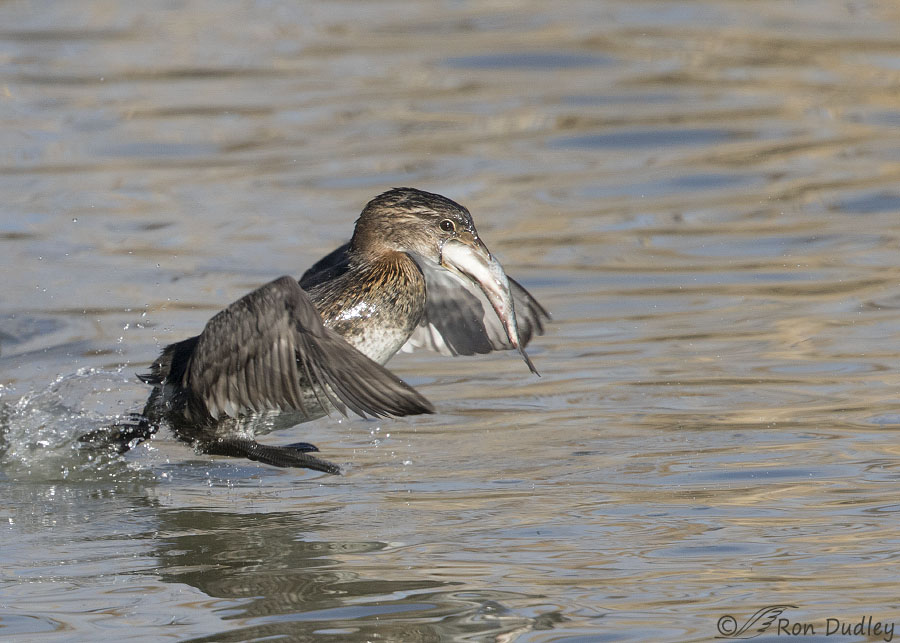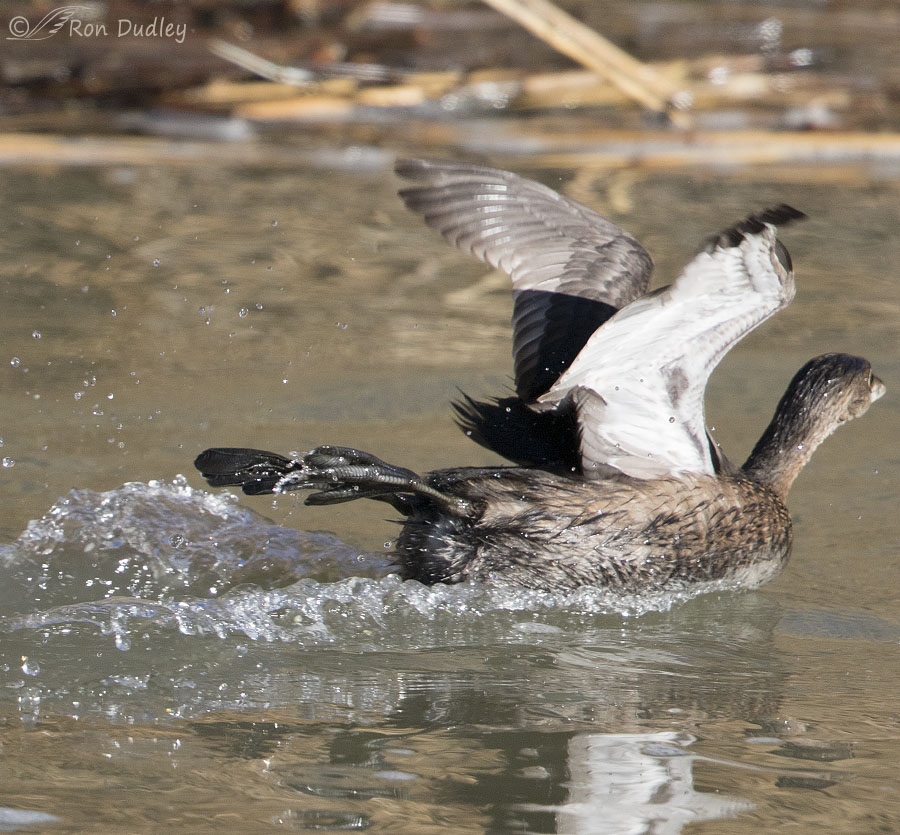I like to challenge my photography skills and this is one of my favorite ways of doing it.
Pied-billed Grebes are known for their mercurial and belligerent behaviors. They often transform from calm, sleepy and almost boring subjects to leg and wing-churning dynamos in a heartbeat as they battle over fishing rights and actual fish. Their small size and incredible but unpredictable speed make them very difficult to follow with a long lens so photographing their scrappy behaviors is a real challenge and great practice for the photographer.
This time of year the 4-way pond at Farmington is often loaded with Pied-billed Grebes and since most photographers ignore them they’re a double draw for me because I like to document their feisty behaviors and I don’t enjoy photographing in crowds.

1/4000, f/6.3, ISO 640, Canon 7D Mark II, Canon EF 500mm f/4L IS II USM + EF 1.4 III Extender, not baited, set up or called in
When this grebe captured a fish that was too large to swallow quickly it immediately had competition for the fish when another grebe rushed in and attempted to steal it. The photographer can often predict that the rightful owner of the fish will run across the water in an attempt to escape with its prize but you can’t predict what direction they’ll take or when it will happen so getting them in frame and sharp while they’re running is very difficult.
In this case the pursuing grebe was right on the heels of the grebe with the fish so this was a serious attempt at escape and the action was incredibly fast. I got a few other shots of both grebes during the encounter but not many of them were sharp enough. I was lucky to get this one as sharp as I did (a fast shutter speed helped to save my bacon once again).
Birds are generally scarce this unusually warm winter so I’ll practice on grebes more often than usual. Like most bird photographers I can use all the practice I can get.
Ron
Late addendum:
Facebook friend Muffy Gately asked to see a photo of the grebe that was chasing the one with the fish. I never did get both birds in the same frame but this shot (below) shows that second bird just at the moment it gave up the chase. It makes me smile…



Outstanding action shots Ron!
Charlotte
Run softly and carry a big fish! 😉 Another spectacular high degree of difficulty shot, Ron! I’m more than happy seeing your “practice” shots! 🙂
I like your take on TR, Marty! Thank you.
Ron,
Nice shot as always. That fish is huge! I echo Ricardo’s question. And I would admit that birds are scarce this winter. I guess I need to pay more attention to the ones that are there. You have a great talent of making the common very interesting! Thanks.
Stephen
“You have a great talent of making the common very interesting”.
I appreciate that sentiment very much, Stephen. Thank you!
I’ve answered Ricardo’s question below.
That appears to be a big fish considering the size of the Grebe’s mouth.
I can’t imagine swallowing my food whole or needing to escape something trying to take it away. A great shot, Ron.
Alice, one of the reasons many birds swallow their food whole is because they don’t have teeth for chewing. Teeth are heavy and their lack of teeth is actually an adaptation for flight (less weight – every little bit helps).
Just WOW (not to be ridiculously redundant or anything)! What a terrific image! But again with the redundancy 😉
I just love these behavioral shots–a who big bunch! You’re seeing behaviors I never knew existed, but we know my duck/water bird ID skills are poor to nonexistent since when I’m out there, I’m looking for bunnies and they’re usually not that close to water.
Thank you, Laura.
Great photo Ron! The fast shutter speed 1/4000 sec is great. Even though it looks like the wing tip speed still might be fast enough to slightly blur? This is an eye opener for me, since I shoot in full manual mode and I frequently never go above 1/1600 sec. I think the smaller water fowl,like grebes and golden eyes have very fast moving parts!
Thanks, Ed. for the way I shoot and given my preference for flight and behavior shots fast SS’s are the only way to go IMO. And yes, the smaller the bird the faster they tend to move.
Judy’s comment raises an interesting observation…about running on water and still breathing with a big fish in your bill….their nostrils are not very big….
They seem to tucker out pretty fast when they’re running, Patty.
Great job, Ron. Did you have the speed set at 4000 beforehand in anticipation of the fast action? 4000 is pretty fast. For a bird in flight 2500 is generally fast enough.
Ricardo, I shoot in aperture priority so my SS often varies wildly depending on the light and brightness of my subject and setting. I generally prefer fast SS so I tend to use higher ISO’s to crank it up to the point I sometimes have unnecessarily fast SS for some situations but that gives me wiggle room when it drops.
In my experience 1/2500 is plenty fast enough for larger birds in flight but for smaller birds it’s often too slow.
Thank you Ron, for a very helpful reply.
Great shot! The head and eye are very sharp. I think getting a Grebe running is good; with prey, fantastic! I love it!
Thank you, Richard.
Reminds me of trying to get the back side of a Tree Swallow! Indeed, the tougher the challenge, the sweeter the reward. Great catch for sure! Sadly, your last sentence means I’ll be practicing past eternity.
If we want to improve we’ll ALL be practicing forever, Elmer. Thanks.
Great shot Ron. Between the Kingfishers and Pied-billed Grebes, your camera tracking skills are fantastic.
Sometimes those skills work and sometimes they abandon me at the most critical moments, James. That’s why practice, practice and more practice!
Cool! Still amazing that they can get a fish that size down let alone breath while being pursued! 🙂
They appear to get winded pretty quickly while running like that, Judy.